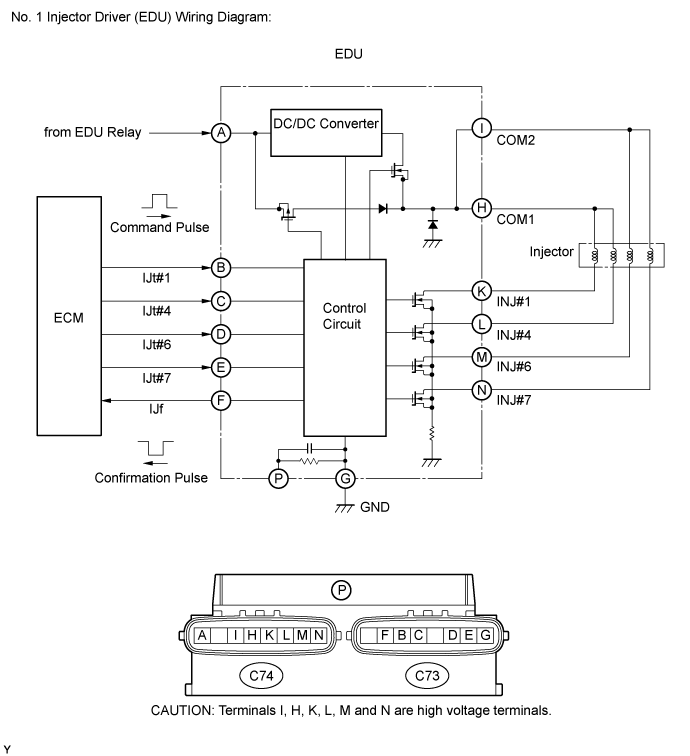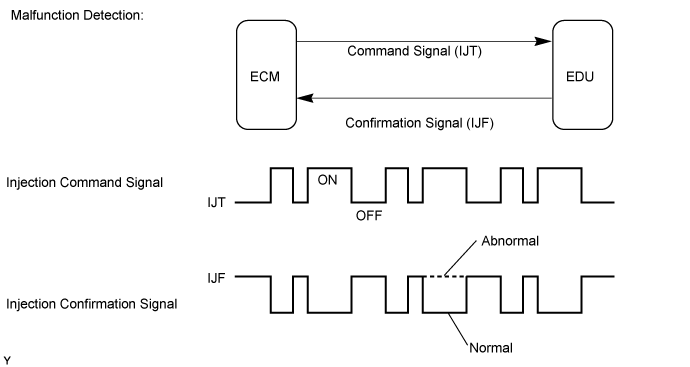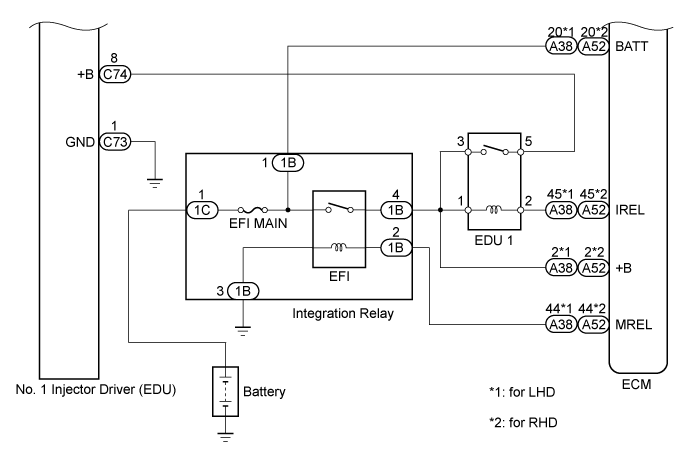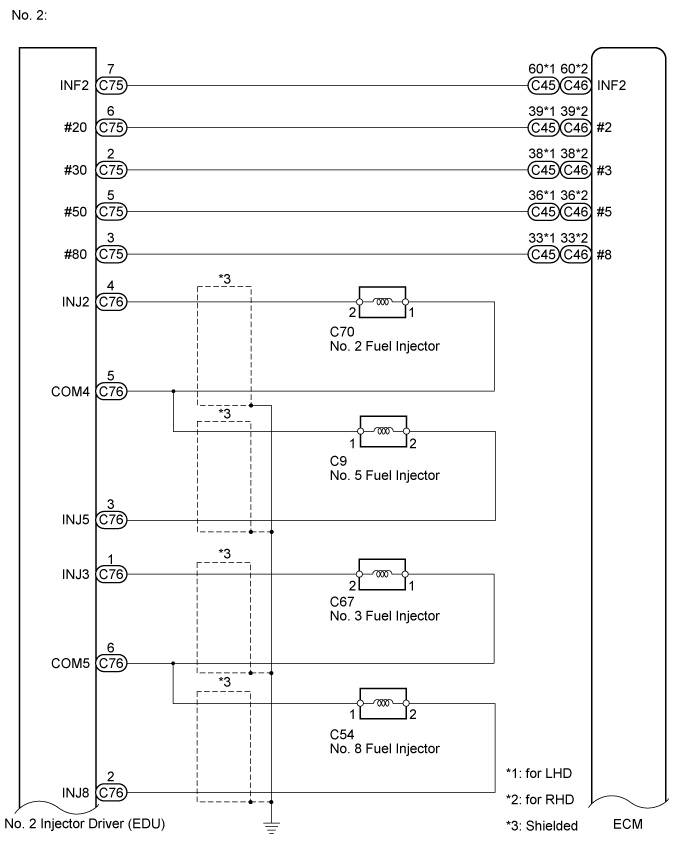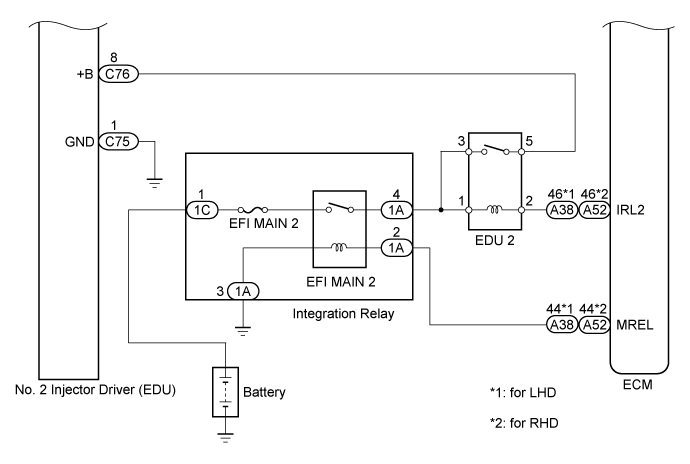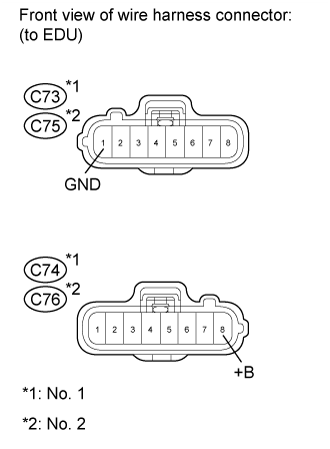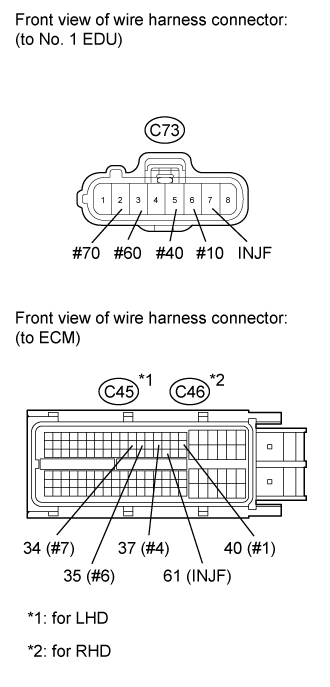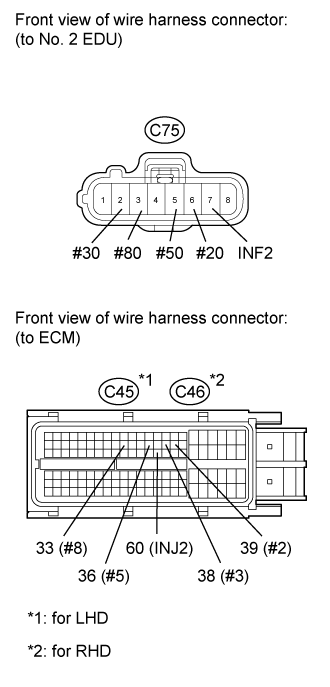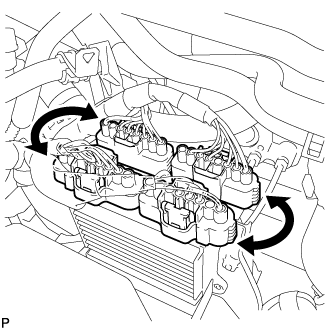Dtc P062D Fuel Injector Driver Circuit Performance Bank1
DESCRIPTION
MONITOR DESCRIPTION
WIRING DIAGRAM
INSPECTION PROCEDURE
CHECK TERMINAL VOLTAGE EDU POWER SOURCE
CHECK HARNESS AND CONNECTOR (FUEL INJECTOR - EDU)
CHECK HARNESS AND CONNECTOR (EDU - ECM)
INSPECT FUEL INJECTOR (RESISTANCE)
INSPECT INJECTOR DRIVER (No. 1 and No. 2)
REPLACE ECM
GO TO INJECTOR CIRCUIT
REPLACE INJECTOR DRIVER (No. 1 or No. 2)
REPLACE FUEL INJECTOR
REPAIR OR REPLACE HARNESS OR CONNECTOR
CONFIRM WHETHER MALFUNCTION HAS BEEN SUCCESSFULLY REPAIRED
DTC P062D Fuel Injector Driver Circuit Performance Bank1 |
DTC P062E Fuel Injector Driver Circuit Performance Bank2 |
DESCRIPTION
The EDU delivers drive signals to fuel injectors using the DC/DC converter, which provides a high-voltage and quick-charging system.Soon after the EDU receives a fuel injection command (IJT) signal from the ECM, the EDU responds to the command with an injector injection confirmation (IJF) signal when the current is applied to the fuel injector.P062DDTC Detection Drive Pattern
| DTC Detection Condition
| Trouble Area
|
Idling for 10 seconds
| Open or short in the No. 1 injector driver (EDU) or fuel injector circuit (1 trip detection logic).
| - Open or short in No. 1 injector driver (EDU) circuit
- Fuel injector
- No. 1 EDU
- ECM
|
P062EDTC Detection Drive Pattern
| DTC Detection Condition
| Trouble Area
|
Idling for 10 seconds
| Open or short in the No. 2 injector driver (EDU) or fuel injector circuit (1 trip detection logic).
| - Open or short in No. 2 injector driver (EDU) circuit
- Fuel injector
- No. 2 EDU
- ECM
|
MONITOR DESCRIPTION
- P062D, P062E (Open or short in EDU or fuel injector circuit):
The ECM continuously monitors both injection command (IJT) signals and injection confirmation (IJF) signals. This DTC will be stored if the ECM determines that the number of IJT signals and IJF signals are inconsistent.
The fuel injectors are grounded over a Field Effect Transistor (FET) and a serial resistor. This resistor creates a voltage drop, which is monitored by the EDU (injector drive circuit) in relation to the current drawn by the fuel injector. When the fuel injector current becomes too high, the voltage drop over the resistor exceeds a specified level and no IJF signal for that cylinder is sent to the ECM.
After the engine is started, when there is no injection confirmation (IJF) signal from the No. 1 or No. 2 EDU to the ECM even though the ECM sends injection command (IJT) signals to the No. 1 or No. 2 EDU, DTC P062D or DTC P062E is stored.
If this DTC is stored, the ECM enters fail-safe mode and limits engine power or stops the engine. The fail-safe mode continues until the ignition switch is turned off.
WIRING DIAGRAM
INSPECTION PROCEDURE
- NOTICE:
- After replacing the ECM, the new ECM needs registration (Click here) and initialization (Click here).
- After replacing a fuel injector, the ECM needs registration (Click here).
- HINT:
- Read freeze frame data using the intelligent tester. Freeze frame data records the engine condition when malfunctions are detected. When troubleshooting, freeze frame data can help determine if the vehicle was moving or stationary, if the engine was warmed up or not, and other data from the time the malfunction occurred.
| 1.CHECK TERMINAL VOLTAGE EDU POWER SOURCE |
Disconnect the No. 1 injector driver (EDU) connectors.
Disconnect the No. 2 injector driver (EDU) connectors.
Measure the voltage according to the value(s) in the table below.
- Standard Voltage:
No. 1Tester Connection
| Switch Condition
| Specified Condition
|
C74-8 (+B) - C73-1 (GND)
| Ignition switch ON
| 11 to 14 V
|
No. 2Tester Connection
| Switch Condition
| Specified Condition
|
C76-8 (+B) - C75-1 (GND)
| Ignition switch ON
| 11 to 14 V
|
| 2.CHECK HARNESS AND CONNECTOR (FUEL INJECTOR - EDU) |
Disconnect the fuel injector connectors.
Disconnect the No. 1 EDU connector.
Measure the resistance according to the value(s) in the table below.
- Standard Resistance (Check for Open):
No. 1Tester Connection
| Condition
| Specified Condition
|
C5-2 - C74-4 (INJ1)
| Always
| Below 1 Ω
|
C14-2 - C74-3 (INJ4)
| Always
| Below 1 Ω
|
C69-2 - C74-2 (INJ6)
| Always
| Below 1 Ω
|
C68-2 - C74-1 (INJ7)
| Always
| Below 1 Ω
|
C5-1 - C74-5 (COM1)
| Always
| Below 1 Ω
|
C14-1 - C74-5 (COM1)
| Always
| Below 1 Ω
|
C69-1 - C74-6 (COM2)
| Always
| Below 1 Ω
|
C68-1 - C74-6 (COM2)
| Always
| Below 1 Ω
|
- Standard Resistance (Check for Short):
No. 1Tester Connection
| Condition
| Specified Condition
|
C5-2 or C74-4 (INJ1) - Body ground
| Always
| 10 kΩ or higher
|
C14-2 or C74-3 (INJ4) - Body ground
| Always
| 10 kΩ or higher
|
C69-2 or C74-2 (INJ6) - Body ground
| Always
| 10 kΩ or higher
|
C68-2 or C74-1 (INJ7) - Body ground
| Always
| 10 kΩ or higher
|
C5-1 or C74-5 (COM1) - Body ground
| Always
| 10 kΩ or higher
|
C14-1 or C74-5 (COM1) - Body ground
| Always
| 10 kΩ or higher
|
C69-1 or C74-6 (COM2) - Body ground
| Always
| 10 kΩ or higher
|
C68-1 or C74-6 (COM2) - Body ground
| Always
| 10 kΩ or higher
|
Disconnect the fuel injector connectors.
Disconnect the No. 2 EDU connector.
Measure the resistance according to the value(s) in the table below.
- Standard Resistance (Check for Open):
No. 2Tester Connection
| Condition
| Specified Condition
|
C70-2 - C76-4 (INJ2)
| Always
| Below 1 Ω
|
C9-2 - C76-3 (INJ5)
| Always
| Below 1 Ω
|
C67-2 - C76-1 (INJ3)
| Always
| Below 1 Ω
|
C54-2 - C76-2 (INJ8)
| Always
| Below 1 Ω
|
C70-1 - C76-5 (COM4)
| Always
| Below 1 Ω
|
C9-1 - C76-5 (COM4)
| Always
| Below 1 Ω
|
C67-1 - C76-6 (COM5)
| Always
| Below 1 Ω
|
C54-1 - C76-6 (COM5)
| Always
| Below 1 Ω
|
- Standard Resistance (Check for Short):
No. 2Tester Connection
| Condition
| Specified Condition
|
C70-2 or C76-4 (INJ2) - Body ground
| Always
| 10 kΩ or higher
|
C9-2 or C76-3 (INJ5) - Body ground
| Always
| 10 kΩ or higher
|
C67-2 or C76-1 (INJ3) - Body ground
| Always
| 10 kΩ or higher
|
C54-2 or C76-2 (INJ8) - Body ground
| Always
| 10 kΩ or higher
|
C70-1 or C76-5 (COM4) - Body ground
| Always
| 10 kΩ or higher
|
C9-1 or C76-5 (COM4) - Body ground
| Always
| 10 kΩ or higher
|
C67-1 or C76-6 (COM5) - Body ground
| Always
| 10 kΩ or higher
|
C54-1 or C76-6 (COM5) - Body ground
| Always
| 10 kΩ or higher
|
| 3.CHECK HARNESS AND CONNECTOR (EDU - ECM) |
Disconnect the No. 1 EDU connector.
Disconnect the ECM connector.
Measure the resistance according to the value(s) in the table below.
- Standard Resistance (Check for Open):
No. 1 (for LHD)Tester Connection
| Condition
| Specified Condition
|
C73-6 (#10) - C45-40 (#1)
| Always
| Below 1 Ω
|
C73-5 (#40) - C45-37 (#4)
| Always
| Below 1 Ω
|
C73-3 (#60) - C45-35 (#6)
| Always
| Below 1 Ω
|
C73-2 (#70) - C45-34 (#7)
| Always
| Below 1 Ω
|
C73-7 (INJF) - C45-61 (INJF)
| Always
| Below 1 Ω
|
No. 1 (for RHD)Tester Connection
| Condition
| Specified Condition
|
C73-6 (#10) - C46-40 (#1)
| Always
| Below 1 Ω
|
C73-5 (#40) - C46-37 (#4)
| Always
| Below 1 Ω
|
C73-3 (#60) - C46-35 (#6)
| Always
| Below 1 Ω
|
C73-2 (#70) - C46-34 (#7)
| Always
| Below 1 Ω
|
C73-7 (INJF) - C46-61 (INJF)
| Always
| Below 1 Ω
|
- Standard Resistance (Check for Short):
No. 1 (for LHD)Tester Connection
| Condition
| Specified Condition
|
C73-6 (#10) or C45-40 (#1) - Body ground
| Always
| 10 kΩ or higher
|
C73-5 (#40) or C45-37 (#4) - Body ground
| Always
| 10 kΩ or higher
|
C73-3 (#60) or C45-35 (#6) - Body ground
| Always
| 10 kΩ or higher
|
C73-2 (#70) or C45-34 (#7) - Body ground
| Always
| 10 kΩ or higher
|
C73-7 (INJF) or C45-61 (INJF) - Body ground
| Always
| 10 kΩ or higher
|
No. 1 (for RHD)Tester Connection
| Condition
| Specified Condition
|
C73-6 (#10) or C46-40 (#1) - Body ground
| Always
| 10 kΩ or higher
|
C73-5 (#40) or C46-37 (#4) - Body ground
| Always
| 10 kΩ or higher
|
C73-3 (#60) or C46-35 (#6) - Body ground
| Always
| 10 kΩ or higher
|
C73-2 (#70) or C46-34 (#7) - Body ground
| Always
| 10 kΩ or higher
|
C73-7 (INJF) or C46-61 (INJF) - Body ground
| Always
| 10 kΩ or higher
|
Disconnect the No. 2 EDU connector.
Disconnect the ECM connector.
Measure the resistance according to the value(s) in the table below.
- Standard Resistance (Check for Open):
No. 2 (for LHD)Tester Connection
| Condition
| Specified Condition
|
C75-6 (#20) - C45-39 (#2)
| Always
| Below 1 Ω
|
C75-2 (#30) - C45-38 (#3)
| Always
| Below 1 Ω
|
C75-5 (#50) - C45-36 (#5)
| Always
| Below 1 Ω
|
C75-3 (#80) - C45-33 (#8)
| Always
| Below 1 Ω
|
C75-7 (INF2) - C45-60 (INF2)
| Always
| Below 1 Ω
|
No. 2 (for RHD)Tester Connection
| Condition
| Specified Condition
|
C75-6 (#20) - C46-39 (#2)
| Always
| Below 1 Ω
|
C75-2 (#30) - C46-38 (#3)
| Always
| Below 1 Ω
|
C75-5 (#50) - C46-36 (#5)
| Always
| Below 1 Ω
|
C75-3 (#80) - C46-33 (#8)
| Always
| Below 1 Ω
|
C75-7 (INF2) - C46-60 (INF2)
| Always
| Below 1 Ω
|
- Standard Resistance (Check for Short):
No. 2 (for LHD)Tester Connection
| Condition
| Specified Condition
|
C75-6 (#20) or C45-39 (#2) - Body ground
| Always
| 10 kΩ or higher
|
C75-2 (#30) or C45-38 (#3) - Body ground
| Always
| 10 kΩ or higher
|
C75-5 (#50) or C45-36 (#5) - Body ground
| Always
| 10 kΩ or higher
|
C75-3 (#80) or C45-33 (#8) - Body ground
| Always
| 10 kΩ or higher
|
C75-7 (INF2) or C45-60 (INF2) - Body ground
| Always
| 10 kΩ or higher
|
No. 2 (for RHD)Tester Connection
| Condition
| Specified Condition
|
C75-6 (#20) or C46-39 (#2) - Body ground
| Always
| 10 kΩ or higher
|
C75-2 (#30) or C46-38 (#3) - Body ground
| Always
| 10 kΩ or higher
|
C75-5 (#50) or C46-36 (#5) - Body ground
| Always
| 10 kΩ or higher
|
C75-3 (#80) or C46-33 (#8) - Body ground
| Always
| 10 kΩ or higher
|
C75-7 (INF2) or C46-60 (INF2) - Body ground
| Always
| 10 kΩ or higher
|
| 4.INSPECT FUEL INJECTOR (RESISTANCE) |
Disconnect the fuel injector connectors.
Measure the resistance according to the value(s) in the table below.
- Standard Resistance:
Tester Connection
| Condition
| Specified Condition
|
1 - 2
| 20°C (68°F)
| 0.85 to 1.05 Ω
|
| 5.INSPECT INJECTOR DRIVER (No. 1 and No. 2) |
Interchange the No. 1 and No. 2 EDU connectors.
Connect the intelligent tester to the DLC3.
Turn the ignition switch to ON and turn the tester on.
Clear the DTCs (Click here).
- NOTICE:
- Before clearing the DTCs, write them down.
Start the engine.
Enter the following menus: Powertrain / Engine / DTC.
Read the DTCs.
ResultResult
| Proceed to
|
DTCs do not change
| A
|
DTCs change (change in malfunctioning cylinder or EDU code)
| B
|
Replace the ECM (Click here).
Go to the injector circuit (Click here).
| 8.REPLACE INJECTOR DRIVER (No. 1 or No. 2) |
Replace the injector driver (No. 1 or No. 2) (Click here).
Replace the fuel injector (Click here).
| 10.REPAIR OR REPLACE HARNESS OR CONNECTOR |
| 11.CONFIRM WHETHER MALFUNCTION HAS BEEN SUCCESSFULLY REPAIRED |
Connect the intelligent tester to the DLC3.
Clear the DTCs (Click here).
Turn the ignition switch off.
Start the engine and idle it for 10 seconds.
Enter the following menus: Powertrain / Engine / DTC.
Confirm that the DTC is not output again.
